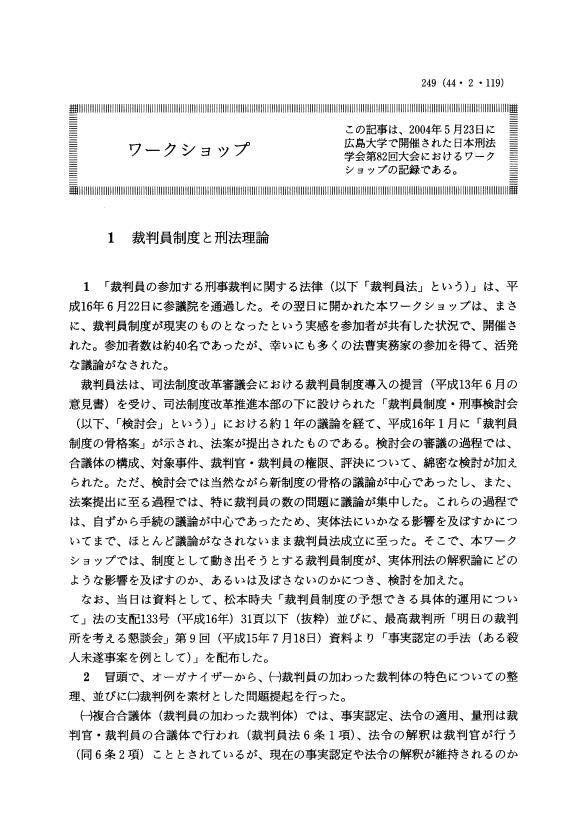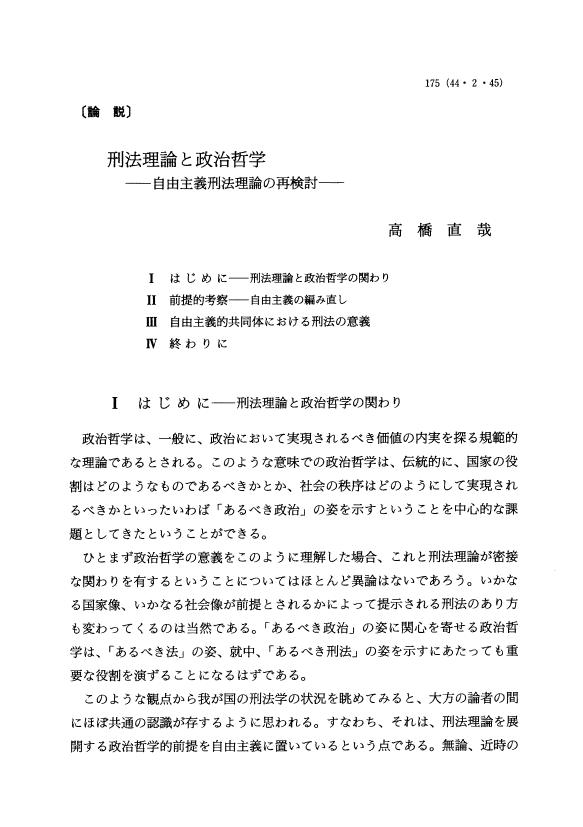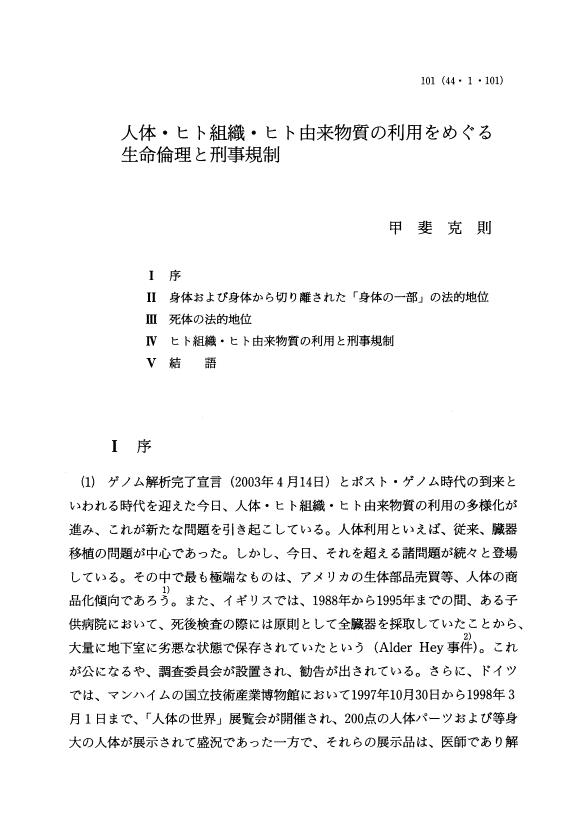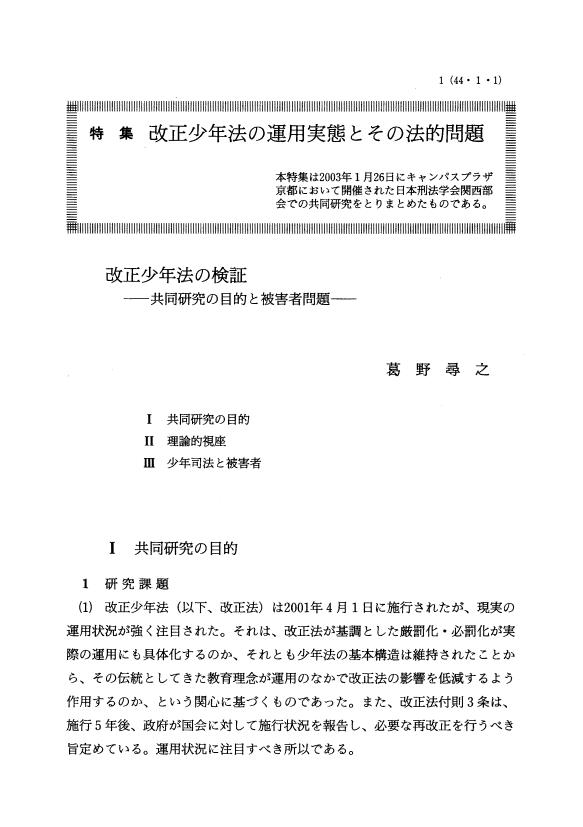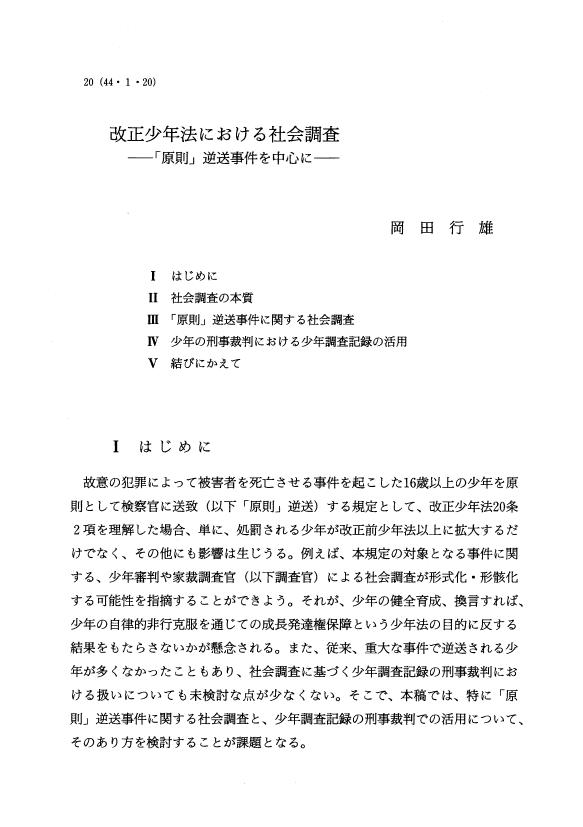1 0 0 0 OA 4 精密司法の意義と限界
- 著者
- 福島 至
- 出版者
- 日本刑法学会
- 雑誌
- 刑法雑誌 (ISSN:00220191)
- 巻号頁・発行日
- vol.44, no.2, pp.261-264, 2005-02-15 (Released:2020-11-05)
1 0 0 0 OA 2 刑法の哲学的基礎 カント・ヘーゲルと現代刑罰論
- 著者
- 松生 建
- 出版者
- 日本刑法学会
- 雑誌
- 刑法雑誌 (ISSN:00220191)
- 巻号頁・発行日
- vol.44, no.2, pp.253-256, 2005-02-15 (Released:2020-11-05)
1 0 0 0 OA 1 裁判員制度と刑法理論
- 著者
- 木村 光江
- 出版者
- 日本刑法学会
- 雑誌
- 刑法雑誌 (ISSN:00220191)
- 巻号頁・発行日
- vol.44, no.2, pp.249-252, 2005-02-15 (Released:2020-11-05)
1 0 0 0 OA 3 不作為犯と正犯原理
- 著者
- 小田 直樹
- 出版者
- 日本刑法学会
- 雑誌
- 刑法雑誌 (ISSN:00220191)
- 巻号頁・発行日
- vol.44, no.2, pp.257-260, 2005-02-15 (Released:2020-11-05)
1 0 0 0 OA 生命発生の周辺をめぐる生命倫理と刑事規制
- 著者
- 辰井 聡子
- 出版者
- 日本刑法学会
- 雑誌
- 刑法雑誌 (ISSN:00220191)
- 巻号頁・発行日
- vol.44, no.1, pp.82-93, 2004-08-10 (Released:2020-11-05)
1 0 0 0 OA 近年の生命倫理指針の動向と問題点
- 著者
- 佐藤 恵子
- 出版者
- 日本刑法学会
- 雑誌
- 刑法雑誌 (ISSN:00220191)
- 巻号頁・発行日
- vol.44, no.1, pp.65-81, 2004-08-10 (Released:2020-11-05)
1 0 0 0 OA 刑事手続における訴訟行為の再現可能性について
- 著者
- 松田 岳士
- 出版者
- 日本刑法学会
- 雑誌
- 刑法雑誌 (ISSN:00220191)
- 巻号頁・発行日
- vol.44, no.2, pp.160-174, 2005-02-15 (Released:2020-11-05)
1 0 0 0 OA 刑法理論と政治哲学 自由主義刑法理論の再検討
- 著者
- 髙橋 直哉
- 出版者
- 日本刑法学会
- 雑誌
- 刑法雑誌 (ISSN:00220191)
- 巻号頁・発行日
- vol.44, no.2, pp.175-190, 2005-02-15 (Released:2020-11-05)
1 0 0 0 OA 人体・ヒト組織・ヒト由来物質の利用をめぐる生命倫理と刑事規制
- 著者
- 甲斐 克則
- 出版者
- 日本刑法学会
- 雑誌
- 刑法雑誌 (ISSN:00220191)
- 巻号頁・発行日
- vol.44, no.1, pp.101-118, 2004-08-10 (Released:2020-11-05)
1 0 0 0 OA 国際刑法と国内刑事司法
- 著者
- ヴェルレ ゲーアハルト オステン フィリップ
- 出版者
- 日本刑法学会
- 雑誌
- 刑法雑誌 (ISSN:00220191)
- 巻号頁・発行日
- vol.44, no.2, pp.131-141, 2005-02-15 (Released:2020-11-05)
1 0 0 0 OA 付添人の援助を受ける権利の公的保障
- 著者
- 武内 謙治
- 出版者
- 日本刑法学会
- 雑誌
- 刑法雑誌 (ISSN:00220191)
- 巻号頁・発行日
- vol.44, no.1, pp.49-57, 2004-08-10 (Released:2020-11-05)
1 0 0 0 OA 改正少年法の検証 共同研究の目的と被害者問題
- 著者
- 葛野 尋之
- 出版者
- 日本刑法学会
- 雑誌
- 刑法雑誌 (ISSN:00220191)
- 巻号頁・発行日
- vol.44, no.1, pp.1-9, 2004-08-10 (Released:2020-11-05)
1 0 0 0 OA 少年審判における「事実認定の適正化」と検察官関与システム
- 著者
- 中川 孝博
- 出版者
- 日本刑法学会
- 雑誌
- 刑法雑誌 (ISSN:00220191)
- 巻号頁・発行日
- vol.44, no.1, pp.30-39, 2004-08-10 (Released:2020-11-05)
1 0 0 0 OA 改正少年法における社会調査 「原則」逆送事件を中心に
- 著者
- 岡田 行雄
- 出版者
- 日本刑法学会
- 雑誌
- 刑法雑誌 (ISSN:00220191)
- 巻号頁・発行日
- vol.44, no.1, pp.20-29, 2004-08-10 (Released:2020-11-05)
1 0 0 0 OA 「改正」少年法における逆送後の刑事裁判の現状と課題
- 著者
- 渕野 貴生
- 出版者
- 日本刑法学会
- 雑誌
- 刑法雑誌 (ISSN:00220191)
- 巻号頁・発行日
- vol.44, no.1, pp.40-48, 2004-08-10 (Released:2020-11-05)
1 0 0 0 OA Locational Factors of Japanese-Affiliated Companies in the High Plains, the United States of America
- 著者
- Shigeo TAKAHASHI
- 出版者
- The Association of Japanese Geographers
- 雑誌
- Geographical review of Japan, Series B (ISSN:02896001)
- 巻号頁・発行日
- vol.74, no.2, pp.212-222, 2001-12-01 (Released:2008-12-25)
- 参考文献数
- 21
Reflecting the diversification of business activities of Japanese-affiliated companies in the US., the location of such companies is changing from a ready-made pattern of concentration into a large metropolitan area towards a rather dispersed one. An increasing number of Japanese-affiliated companies have established their business bases in the interior of the US. In this paper, locational factors of Japanese-affiliated companies in the High Plains region of the U. S, are examined in order to understand this trend. It appears that various factors, in addition to agglomeration economies, are working to stimulate the establishment of business bases in the High Plains.
- 著者
- Shin KAJITA
- 出版者
- The Association of Japanese Geographers
- 雑誌
- Geographical review of Japan, Series B (ISSN:02896001)
- 巻号頁・発行日
- vol.74, no.2, pp.147-158, 2001-12-01 (Released:2008-12-25)
- 参考文献数
- 27
- 被引用文献数
- 1
This paper aims to summarize the mechanisms of public investment as a social policy in remote rural areas in Japan. It includes findings from former studies as well as a case study undertaken in Shimane by the author, and it discusses the function of public investment in terms of the relationship between the three major groupings involved in the local civil engineering industry. These groups are the “primary labor force group” (PLG) which consists of workers born before or in 1935, the “secondary labor force group” (SLG) which consists of workers born after 1935, and the “local civil engineering companies” (LCECs). In the 1970s and 1980s. there was a strong mutual dependence between the PLG and the LCECs in remote rural areas. PLG workers gave higher priority to maintaining a traditional rural lifestyle and hoped to find jobs in their local area, hence jobs for them should have been created through public works projects. The LCECs also wanted a cheap and quantitatively flexible labor force for public works projects, so public investment worked effectively as a regional social policy. However, as the PLG workers retired and a new generation of workers entered the work force, the disparity between the supply of and demand for labor in the civil engineering industry has increased and the role of public investment as a social policy has been weakened. These changes suggest that the so-called “kaso problem” is generation-specific and that public investment as a social policy for remote rural areas is nearing its end.
- 著者
- Aung KYAW
- 出版者
- The Association of Japanese Geographers
- 雑誌
- Geographical review of Japan, Series B (ISSN:02896001)
- 巻号頁・発行日
- vol.74, no.2, pp.199-211, 2001-12-01 (Released:2008-12-25)
- 参考文献数
- 19
There are two steps in Technopolis development: attraction of high-tech industries to the designated areas, and construction of technology linkages between these incoming high-tech plants, existing plants, local universities and government R & Ds. The latter step of Technopolis development is examined in this paper using the example of Koriyama technopolis. Data used in this study are derived from questionnaire surveys and personal interviews with the high-tech plant managers in the Koriyama technopolis area. It turns out that industry-university-government technology linkage formation is not well developed due to the absence of proper information channels and lack of interest from the high-tech plants in the results of technological cooperation. These problems seem to stem from the nature of branch plants and the historical technological development of Japan. Therefore, a long time period is necessary for the formation of technology linkages in provincial areas.
- 著者
- Juliet Mavis BOON
- 出版者
- The Association of Japanese Geographers
- 雑誌
- Geographical review of Japan, Series B (ISSN:02896001)
- 巻号頁・発行日
- vol.74, no.2, pp.159-186, 2001-12-01 (Released:2008-12-25)
- 参考文献数
- 66
- 被引用文献数
- 3 3
Urbanization and monetization systems have contributed to the reclamation and exploitation of mangroves, which have had some significant effects on the livelihood of those who rely on it. Informal uses of mangroves have received very little attention because they do not contribute to national revenue, and the inextricably linked effects of urbanization and monetary systems on mangrove degradation is lacking. The purpose of this study is to examine the socio-economic impacts of development on mangrove ecosystems and those who depend on it in four coastal villages of Samoa. Fifty households' questionnaire-assisted interviews were conducted first, to provide the social, cultural and economic value of mangroves to the local inhabitants. Second, to identify activities that have changed mangrove ecosystems, and then, to examine how these activities have changed the local inhabitants' social, cultural, and economic relationships with their environment. Findings suggest that, in two cases, land reclamation has strictly and seriously degraded mangrove resources particularly in terms of marine food supplies. For two other cases, increased accessibility to town and the monetization of the rural economy are also factors involved in the decline in quantity and size of fish catch due to the increasing reliance on sales of mangrove food resource for cash. This study supports the position that modern developmental initiatives must be carefully monitored to ensure that they do not undermine the social and economic well-being of resident communities, particularly in areas such as Samoa where a large proportion of the population relies on land and marine resources for their survival.
- 著者
- Abdou Khadre DIAGNE
- 出版者
- The Association of Japanese Geographers
- 雑誌
- Geographical review of Japan, Series B (ISSN:02896001)
- 巻号頁・発行日
- vol.74, no.1, pp.62-77, 2001-06-30 (Released:2008-12-25)
- 参考文献数
- 22
- 被引用文献数
- 1 1
Since the 1970s, tourism development in the Senegalese Petite Cote has rapidly expanded, with diverse impacts in a number of spheres. The human and physical geography of the Petite Cote and its ecosystems are being powerfully shaped by the new entrepreneurial activity. What changes, positive and negative, has tourism brought along the coastline How can locals be better integrated into the tourism sector How can sustainable tourism development be effectively promoted here To assess the impacts of coastal tourism, questionnaire surveys were conducted in 1999 and 2001 in three focal areas for tourism in Sali resort. The surveys indicate that tourism has significantly modified traditional social structure and spawned an array of new social ills, such as prostitution and theft. The tourism boom has transformed many villages into satellites for cheap menial labor. The present investigation can be usefully viewed as a concrete case study of unsustainable tourism development. Despite the fast pace of tourism expansion, it is still oriented largely to maximizing returns, with the evident exclusion of most of the local population. Numerous tourism-related pollutants now plague the environment of traditional villages. It is argued that locals should be better integrated into the tourism process and pollution must be dealt with by rigorous new measures with an aim to promoting more sustainable development in harmony with the local economy and ecology. In particular, necessary skill levels among locals must be upgraded; concomitantly, traditional activities can be reinforced within an eco-tourism framework geared to attracting more tourists interested in an alternative type of holiday experience.


